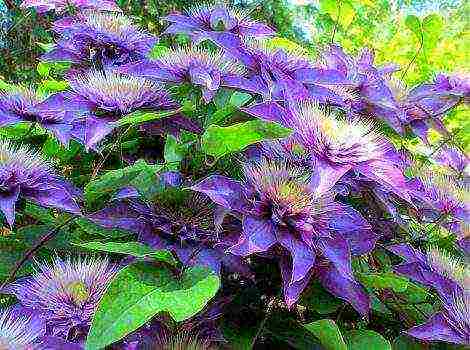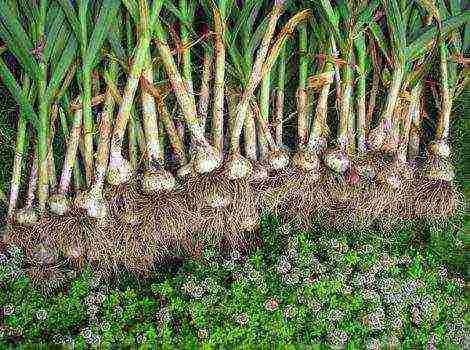Content
- 1 Requirements for growing conditions
- 2 Sowing corn on the beds
- 3 Growing seedlings
- 4 After landing
- 5 Watering and feeding
- 6 Variety selection
- 7 Preparing corn seeds
- 8 Growing seedlings
- 9 Site selection, soil preparation, sowing corn seeds in the ground
- 10 How to plant?
- 11 Outdoor corn care
- 12 Harvesting and storage
- 13 Planting sweet corn on video
The delicate and rich taste of sweet cobs, densely stuffed with juicy grains, yellow, like little suns, have been loved by everyone since childhood. But growing corn on a personal plot seems ungrateful to many gardeners. To collect a generous crop from its bushes, which has reached technical ripeness, you will have to work hard, and first of all, get the necessary knowledge about agricultural agricultural technology.

Requirements for growing conditions
Corn loves warmth. It is mainly cultivated in the southern regions of the country. But it is possible to breed a culture in a temperate climate and even in the much harsher conditions of Siberia. The main thing is to choose the right place for the corn and provide competent care for the plantings. Outdoors, it grows best in areas with maximum sunlight. In the shade and with a lack of heat, the development of its bushes slows down, and the grain on the cob does not ripen to milk ripeness. Plants are sensitive to cold winds and drafts, so it is important to reliably protect the beds from them.
Sweet corn has no special requirements for the quality and structure of the soil. The ideal option for her is light, fertile soil with low acidity, rich in humus and well-drained. It is better to plant corn bushes in a personal plot next to legumes, tomatoes, cucumbers, pumpkin. It will be unsuccessful to place them near the beds with table beets and celery.
They begin to prepare a place for future corn beds in the garden in the fall. This is especially important when cultivating early maturing varieties. The soil is carefully dug up, choosing the roots of weeds from it. It is correct to do this early, before the first frost. Then the site can be watered abundantly so that the weed seeds that have fallen into it will sprout, and then weed them out. If these recommendations are followed, the spring preparation of the garden will be easier, and planting maintenance will require less time and effort.
Sweet corn responds well to fertilization. Preparing the soil for the beds, they are brought in twice: in autumn and spring. Before winter, they are scattered around the site (by 1 m2):
- humus (5 kg);
- double superphosphate (0.2 kg);
- potassium salt (0.1 kg).
Fertilizers are buried in the ground by digging to the depth of a bayonet shovel. Spring preparation of the site is less intensive. Before planting corn kernels, the soil is fertilized with nitrophos (50 g of the preparation per 1 m²), and then slightly pushed. The procedure is carried out 2–2.5 weeks before the planned date of sowing the seeds. The earth with high acidity is additionally limed.
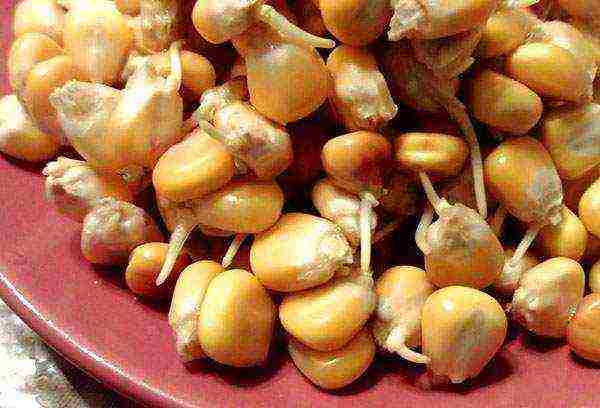
Sowing corn on the beds
Planting corn with seeds is a simple and quite effective way of growing a crop. Its terms are determined by the characteristics of the local climate. To get friendly shoots, corn grain is sown when the weather is warm and the threat of frost has passed. The thermometer should not fall below 10-12 ° C during the day. In Siberia, you can start planting corn closer to mid-May.
The result will be better if the seeds are prepared before placing in the ground. Professionals advise to soak them. There is nothing complicated in this procedure, for it you will need:
- a piece of gauze, burlap or any other fabric;
- some wood ash;
- the corn itself.
You need to soak the seeds according to certain rules.The fertilizer is thoroughly dissolved in water heated to 22-25 ° C. Then, corn seeds are dipped into this nutrient composition. They do not keep them in it for a long time, 12 hours are enough. An envelope is made of gauze, it is abundantly moistened with a prepared solution and the planting material is placed in it. The condition of the seeds will be checked daily to ensure they are supplied with oxygen. If they have not yet hatched, they are mixed, if necessary, moistened and covered with gauze again. Finish these manipulations when the first shoots appear.
The sprouted corn grain is placed in a slightly loosened soil, having previously marked grooves in the garden, the interval between which is made equal to 0.5-0.6 m. At a distance of 40 cm from each other, holes of medium depth (6-7 cm) are dug in a row. 3-4 seeds are laid out in them. The square-nest planting scheme is optimal for maize: with this arrangement, self-pollination is successful in adult plants and the yield increases. Then the hole is filled with wet soil, and a layer of dry earth is poured on top as mulch.
Sweet corn springs up pretty quickly. If the seeds are soaked, then young shoots will appear in 10-12 days. If you do without preparation, you will have to wait 5-7 days longer. When corn sprouts appear from the soil, only one more powerful one is left in each of the planting holes, and the rest are pulled out.

Growing seedlings
The seedling method of growing a crop is also popular, in which the crop on plants ripens faster. In this case, planting of corn is carried out earlier - in April. For sowing seeds at home, deep containers filled with a mixture of peat and sand or sawdust are suitable. But it is much more convenient to arrange the corn grain in separate cups. This will save time on the care of the seedlings and reduce the likelihood of damage to their roots when moving to the beds.
Advice
You can also get corn seedlings in the greenhouse. It will be correct to install it at the summer cottage in March, so that by the time the seeds are planted, the soil is warmed up enough.
For germination, corn seeds need temperatures around 18-20 ° C. Fluorescent lamps will help provide them with enough light and heat. Better to install them before sowing. If you ignore these guidelines, young sweet corn will stretch out a lot, and care for its long shoots will be difficult. After watering, they will bend down, practically lying on the ground, and hurt. Any draft will be disastrous for them.
Caring for corn seedlings consists of watering and fertilizing. They need a lot of water, it is impossible to allow the soil to dry out in containers. When the seedlings begin to develop intensively, the time will come for feeding them with a solution of mineral fertilizer. They will also respond well to growth stimulants. Young corn is provided with additional nutrition every week.
It can be placed in open ground from the first days of May, if weather conditions permit. By this time, 2-3 powerful leaves will appear on the seedlings. In regions with a colder climate (in the Urals, in Siberia), the procedure is carried out later - in the last week of spring. It is permissible to postpone it even until the beginning of summer. Pits are made in the permanent area before planting corn bushes. They are watered abundantly. To place plants in the beds, the same scheme is used as for sowing seeds. Correct planting of corn is completed by mulching the surface of the hole. It is sprinkled with sand, which will not allow the soil to become covered with a hard crust.

After landing
It takes little for sweet corn to produce a rich harvest. Planting care includes:
- watering;
- top dressing;
- loosening the soil;
- hilling;
- weed removal.
Sweet corn loves clean beds and light, porous soil through which its roots can breathe freely. It is especially important to follow these rules at the initial stages of the development of its bushes.During this period, loosening is indispensable, but they are stopped as soon as the adventitious roots are formed in the corn. Then the time comes for hilling, which will make the bushes more resilient. They will need to be completed at least 1-2 times per season.
Corn on the backyard is closely monitored, removing weak shoots and stepchildren from the bushes. It is not worth breaking them out, there is a safer and less traumatic way to the stem - carefully cut them with scissors. If this is not done, they will take away the strength and nutrients from the corn, which are necessary for the grain to be poured and ripen on the cobs. The formation of numerous stepchildren is a reason to think about whether the watering of the beds is carried out correctly. This is how sweet corn most often reacts to a lack of moisture.
But an excess of water will not benefit the plants: depriving the flow of oxygen, their roots may die. Determining waterlogging is easy. The leaves of the corn take on a purple hue, and the development of the bush slows down. As a result, the plant is dwarf in size, and its ears do not fully ripen.
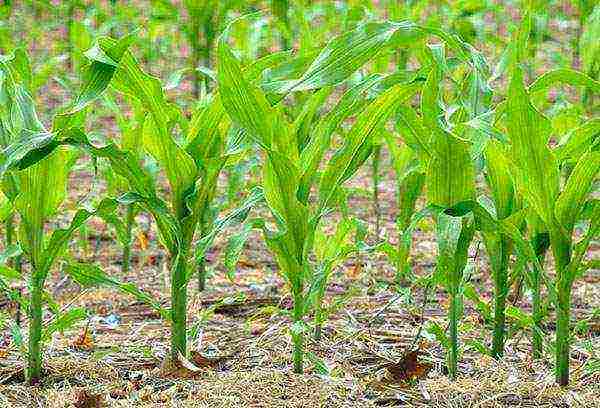
Watering and feeding
Water the plantings once a week or even less often - once every 10 days. The signal for the next moistening is the state of the soil. It's time to start the procedure if it has dried out to a depth of 5 cm. If corn is grown for grain, it needs abundant watering. The soil should be at least 10-12 cm wet. 1.5-2 buckets of water are spent on each hole. It is this dosage that is necessary to obtain ears densely stuffed with tasty grains.
Advice
During the flowering period of corn, which begins closer to mid-summer, depending on the timing of planting and the selected variety, it is recommended to lightly shake the brushes located at the top of the stems. The procedure is carried out in the middle of the day. There is one more way - do not touch the brushes, but simply knock lightly on the base of the stem. This care helps the plants to pollinate.
Tall bushes of corn in open winds are best tied up. The harvest will be more plentiful if the plantings are generously fed. During the season, the beds are fertilized with organic and mineral compounds at least three times. At the germination stage, as soon as the young sweet corn releases the first leaves, the plants are watered with manure or dung dissolved in water.
The second feeding is carried out at the stage of flowering corn bushes. It’s not scary if this time was lost. Mineral fertilizers containing many trace elements are then applied at a later date - during the formation of the first ovaries on corn. During this period, plants will benefit from wood ash. It can be simply scattered over the surface of the ground. For the full development of corn, 1-2 glasses of fertilizer are enough. Further care for her involves the introduction of drugs, which contain a lot of potassium and phosphorus. Start to it as the cobs grow.
The technology of growing corn is not complicated. With the knowledge and desire to get the long-awaited harvest of ripe ears, even beginners in the gardening business will be able to. Their taste and usefulness were appreciated even by the ancient Indian tribes - the Mayans and the Aztecs. Despite the southern origin of the culture and its tender love for warmth, its zoned varieties are successfully cultivated in the unfavorable conditions for it in the Urals and Siberia.
Corn grain has a rich chemical composition. It contains many vitamins, minerals, amino acids, carbohydrates, proteins. It is nourishing and healthy, and neither adults nor children can resist the unique aroma of juicy freshly boiled ears. But other parts of the plant can also be used on the farm. Livestock loves to feast on its stems and leaves, so certain varieties of the crop have long been grown for silage. The plant is also used in folk medicine: corn silk has a beneficial effect on the liver and helps to reduce appetite.Aren't there enough reasons to make growing corn in your dacha on your to-do list for the coming season?
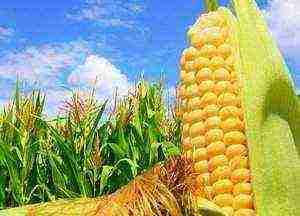 Corn belongs to unpretentious crops that can be grown without a certain amount of experience and knowledge. However, in order to get a good harvest, you still need to know how to properly care for this plant. It is very important to choose the right variety in order to get the maximum yield. Note that some varieties grow best in southern regions, while some varieties should only be grown in northern regions.
Corn belongs to unpretentious crops that can be grown without a certain amount of experience and knowledge. However, in order to get a good harvest, you still need to know how to properly care for this plant. It is very important to choose the right variety in order to get the maximum yield. Note that some varieties grow best in southern regions, while some varieties should only be grown in northern regions.
Which variety to choose
To the most popular varieties include the following:
- "Dobrynya" is an early variety with large ears and sweet taste. This variety resists well such diseases as mosaic, rust and fusarium. The seeds of this variety are especially popular as they have good resistance to fungal diseases.
- "Lakomka 121" - this variety is in no way inferior to "Dobryna" in its sweetness. This type of corn has a high yield and good immunity to various diseases. The ears can be eaten even when they are at the stage of milk ripeness. This kind of corn is great for preserving.
- "Early Gold 4011" is a mid-season variety, the ears grow up to 19 cm in length. Seeds of this variety can be planted directly in open ground. Maintenance is minimal, just watering and removing weeds. The seeds can be planted even after a year of storage.
- Spirit F11 is sweet corn, the first crop, which can be harvested as early as 2 months after the first shoots appear.
Planting corn outdoors: preparing the soil
Before planting, be sure to prepare the soil. Please note that the landing site should not be blown by winds and the water should not stagnate. Otherwise, the yield can be significantly reduced. The soil should be prepared in the fall.... Preparatory work consists of the following stages:
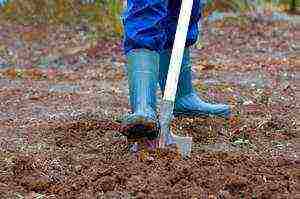 dig up the ground, this is necessary so that the root system has the right amount of oxygen, as well as the necessary space for normal growth;
dig up the ground, this is necessary so that the root system has the right amount of oxygen, as well as the necessary space for normal growth;- apply fertilizers, pay attention to the fact that the soil should be neutral or slightly acidic.
This culture is quite unpretentious to fertilizers, so humus, nitrogen mixtures, as well as fertilizers based on potassium or phosphorus can be used for feeding. Such dressings help speed up the growing season.
In autumn and spring, the soil should treat with herbicides... For the purpose of prevention, it is also necessary to carry out treatment with fungicides and special insecticides. Such preventive actions should be carried out every year.
How and when to enrich the soil
It is best to apply fertilizers after the autumn digging. For feeding, you need 0.5 buckets of humus or compost, 2 tbsp. tablespoons of superphosphate and 1.5 tbsp. tablespoons of potassium sulfate. This amount of fertilizer corresponds to 1 square meter.
During the growing season, the plant should be fed with various organic fertilizers.
In the country, planting corn is needed not only to get fruit, but also to create shade for other vegetables. And also this plant can be a support for beans or beans. Pumpkins are good neighbors for corn, as their leaves will protect the soil from overheating and drought.
How to plant corn outdoors
 When asked how to grow corn, it should be noted that planting in open ground should be carried out when the soil warms up to 12 ° C. The soil should be loosened just before planting.
When asked how to grow corn, it should be noted that planting in open ground should be carried out when the soil warms up to 12 ° C. The soil should be loosened just before planting.
In order for the seeds to germinate faster, they it is necessary to hold for 5 days at a temperature of 35 ° С, and just before planting, they need to be soaked in warm water.
When to plant corn?
This plant should be planted at the end of April, the depth of the planting hole should be no more than 7 cm.If you grow corn in the country, then it is better to plant it in rows, with a distance of 40 cm.
Often this plant planted on the border with cucumbers... In this case, it creates a small shadow and protects from the wind.
In addition to landing in rows, there is another method - square-nested... It consists in the fact that 3 grains are thrown into one hole at once. After the first shoots appear, the strongest and strongest seedling is selected, the other two are removed.
The third disembarkation method - pipeline method... It consists in planting different varieties at intervals of 15 days. This method is great for those who want to have a harvest all summer long.
Planting seeds for seedlings
Seedlings can be planted in open ground at the age of 30 days. Seeds for seedlings should be planted in early May. For planting, it is best to use humus-earthy lumps or peat - ground. So, you immediately isolate the root system of the plant, and when transplanting, you can be sure that it will remain intact. If the roots are damaged, the plant may not take root and die.
Plant seedlings in open ground it is possible already at the beginning of June. By this time, the sprouts should have no more than 3 leaves. The sprouts should be planted immediately with a clod of earth, and after planting, the soil is watered and mulched.
How to care for corn in the country?
 The plant should have regular watering, especially if the summers are dry. For feeding, you can use various organic fertilizers. Chicken or cow dung, superphosphate, as well as potash complexes are perfect.
The plant should have regular watering, especially if the summers are dry. For feeding, you can use various organic fertilizers. Chicken or cow dung, superphosphate, as well as potash complexes are perfect.
Loosen the soil recommended at least 3 times per season. Please note that if the stem is very high, then the depth of treatment should be small. Otherwise, you can damage the adventitious roots of the plant.
Corn should be pinned - remove the lateral processes. Thus, you will significantly increase the yield and the size of the cobs. If the summer is cold, then pollination should be done independently. You can use the manual method or use a spray bottle.
Possible diseases
One of the most common diseases - dusty smut... This disease occurs due to the fungus, which forms oval nodules on the plant. They can occur both on stems, leaves, and on the cob. The affected area should be cleaned up immediately.
Sometimes there is a disease such as helminthosporiosis, which affects the ears. The reason for its appearance is a lack of potassium. Empty and light ears indicate the presence of this disease. In order to prevent the appearance of this disease, potash fertilizers should be applied on time.
Corn can be attacked by the following pests:
- wireworm;
- cotton scoop;
- aphid.
To control pests, you should carefully dig up the ground. When the larvae of the pests reach the surface, they die.
As a result, it should be noted that even an inexperienced vegetable grower can grow corn. Planting corn is a simple matter, the main thing is to choose the right seeds and take good care of it.
>
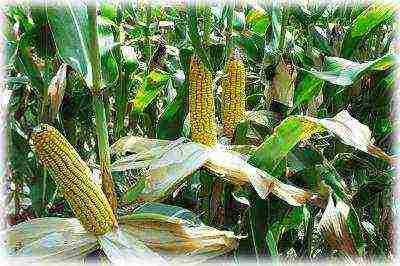 Corn is a favorite delicacy of both adults and children. Porridge, popcorn, butter are prepared from its seeds, and sweet varieties are happily eaten boiled.
Corn is a favorite delicacy of both adults and children. Porridge, popcorn, butter are prepared from its seeds, and sweet varieties are happily eaten boiled.
It is possible to grow this culture not only in the field, but also in the personal plot. Growing corn outdoors is not difficult. Knowing the characteristics of certain varieties, methods of planting and caring for it, you can get a good harvest.
Variety selection
Before you start planting, you need to decide on the purpose of its subsequent use. For popcorn, such varieties as ping-pong, baby, carousel, rice are suitable. Spirit, dobrynya, sanders, triple sweetness - these varieties are suitable for eating, they are distinguished by their sweet taste. Having decided on the “queen of the fields” variety, we choose the necessary planting method.
There are two ways to plant corn in open ground:
- Seeds;
- Through seedlings.
Preparing corn seeds
Selected seeds are warmed up in the sun for 3-4 days, previously tied in a piece of gauze or linen cloth. Next, they are disinfected: they are kept for 30 minutes in a weak solution of potassium permanganate, then washed with warm water. After that, they are thoroughly dried in the usual way.
In order for germination to begin, gauze is taken, folded in several layers and abundantly moistened. Prepared grains are placed on it and placed in a dry place. After 4 days, the first roots will go and you can start planting corn in open ground.
Growing seedlings
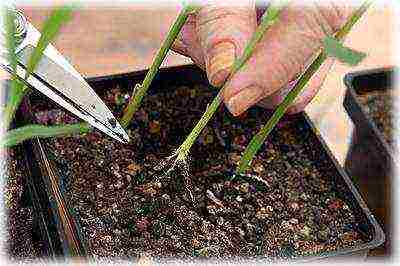 This method is used if you need to get an early harvest. Seedlings are harvested in mid-April. In small containers (more often paper or plastic cups are used), the soil is placed, fertilized with a mixture for planting vegetables.
This method is used if you need to get an early harvest. Seedlings are harvested in mid-April. In small containers (more often paper or plastic cups are used), the soil is placed, fertilized with a mixture for planting vegetables.
At the same time, it must be highly moisturized. Germinated seeds are planted in it and placed in a dry and bright room for two to three weeks. The seedlings are transferred to the ground until the fourth leaf appears on it.
Site selection, soil preparation, sowing corn seeds in the ground
Corn is sown in the warmed-up ground after the final departure of the cold weather. The most suitable period is the second half of May. You need to choose a place sunny, corn does not like shade. A good harvest will be if melons, legumes or buckwheat used to grow on this place. It is undesirable to plant in the place where millet grew before. Cucumbers, zucchini and pumpkins will be a wonderful neighborhood and protection. They will serve as a support for corn, and will enhance the yield of crops from neighboring with each other.
 Before planting corn in open ground, it must initially be dug up with all the weeds that have grown on it. The more, the better. If there is time, then it is advisable to provoke their growth by abundant watering of plain water before digging. After that, you need to add a bucket of compost and fertilizer (mineral fertilizers).
Before planting corn in open ground, it must initially be dug up with all the weeds that have grown on it. The more, the better. If there is time, then it is advisable to provoke their growth by abundant watering of plain water before digging. After that, you need to add a bucket of compost and fertilizer (mineral fertilizers).
The calculation is made per square meter: salt - 100 g, superphosphate - 200 g. In autumn, the soil is fertilized with manure and dug up. In the spring, the same action is repeated two weeks before planting with the addition of matured organic matter (compost, humus).
How to plant?
It is best to plant corn in a square-nesting method. The required distance between the holes is 45 cm, and the planting depth is 3-4 cm. It is good to spill the prepared hole with water. Soil wetting should be 10-15 cm.The width between the rows is about 70 cm.
Outdoor corn care
 Watering
Watering
Despite its resistance to drought, this crop requires abundant watering, albeit infrequently. The moisture content of the ground should be 15 cm deep.
Watering corn in the open field must be carried out in such a way that there are no interruptions in the flow of water.
Otherwise, it will affect the quality of the grain. To avoid damage to the plant, water stagnation should not be allowed. Loosening of the soil will help in this, it is carried out three times per season.
Weeding and loosening
In order for the corn to grow up without hindrance, it is necessary to regularly weed the seedlings and loosen the soil between the rows. Damage to the roots during this procedure can be avoided by reducing the depth of loosening.
Stepping
Cutting off side shoots (stepchildren) is also called grazing. This must be done after the beginning of the appearance of 8 leaves. Thanks to this procedure, the cobs will be larger. You don't need to do this, then small stepchildren will appear before harvesting. They are usually left to be sown next year.
Top dressing
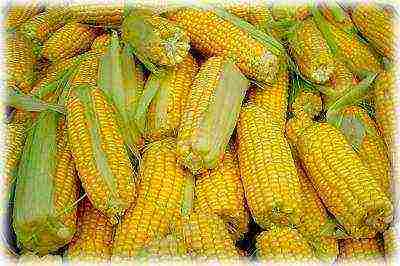 The most suitable feeding is organic. 14 days after germination, it is necessary to fertilize the plant with a solution of mullein and water in a ratio of 1:10.
The most suitable feeding is organic. 14 days after germination, it is necessary to fertilize the plant with a solution of mullein and water in a ratio of 1:10.
Instead of mullein, bird droppings are also taken. In this case, the proportion is 1:20. Ammonium nitrate will serve as a substitute for both solutions. It is added when forming 4 sheets.
Two weeks after feeding with organic matter, phosphorus-potassium fertilization is carried out.
Harvesting and storage
Harvesting corn should be started as soon as it is ripe. You cannot overexpose the plant, this changes the taste of the seeds. You can find out the ripeness of the fruit by pressing on one grain with your fingernail. Milky juice should appear from it. The fibers at the top of the ear should be dark and dry. With these factors present, the crop is ready to be harvested.
Corn is stored in the leaves for no more than a month at a temperature not lower than zero.
Growing and caring for corn in the open field will be mastered even by a novice gardener, and a good harvest will serve as an excellent reason for replanting this vegetable.
Planting sweet corn on video
You can watch how corn is planted using the example of sweet varieties in the video:
Delicious and tender sweet corn has become a common guest on our tables. Sweet maize grows in an ordinary dacha, as it is not too picky.
Corn varieties
At the dachas, two varieties of corn are grown: puffed and sugar. Sugar can be used for food and winter preparations.
Popcorn varieties differ from sweet corn in their small grains. Each grain is covered with a hard shell, which "explodes" when heated. Sweet corn kernels are softer and sweeter.
Popular varieties:
- Gourmet - early ripening variety, ripens in 83-90 days. Plants are low, up to one and a half meters, the length of the cob is up to 18 cm. The seeds are bright yellow, beautiful and sweet.
- Anava - a sweet variety that retains sugar for several days after harvest. Early maturing, ripens in 80-90 days. The height of the stems is up to one and a half meters. The ears are large, more than 20 cm long. The grains are light.
- Delicacy - a variety of sweet corn, considered one of the best for canning. Early maturing, the length of the ears is up to 22 cm. The grains are rich in carotene. Plants of medium height, almost never lodged.
- Madonna - a sweet early variety with small, dense ears. Plants up to 2 meters high. The ears ripen in 3 months. The variety suffers less than others from drought. Madonna has a lot of ears tied, which ripen even on stepsons. The variety is suitable for freezing.
- Air - for making popcorn. The variety is early, the harvest can be obtained in 75-85 days. Plant height up to 1.8 m, cob weight 250-300 g. Grains are small, light yellow.
Table: modern varieties and hybrids of sweet corn
| Mature characteristics | Name |
| Contains 4-6% sugar and a lot of starch | Debut, Kuban bicolor, Bird's milk, Angle, Aphrodite, Bonus, Boston, Spirit |
| Contains 8-10% sugar and medium starch | Super, Sundance, Dimox, Legend |
| Contains more than 10% sugar and little starch | Lollipop, Dobrynya, Elizabeth, Megaton, Paradise, Shamo |
Place in the crop rotation
Corn has no requirements for its predecessor. The culture is not affected by diseases common with other vegetables, with the exception of fusarium.
Good predecessors for maize will be beets, melons, and legumes. With good agricultural technology, corn can be planted in one place for several years. In the south, sweet corn is grown as a second crop after cabbage, green peas and early potatoes.
Corn is an excellent precursor for most garden crops, especially potatoes and root crops. Maize almost does not reduce soil fertility. The roots of the plant are impressive in size. Remaining in the ground for the winter, they decompose and become a source of large amounts of humus.
Landing dates
Sweet corn does not develop at temperatures below 10 degrees and above 30 degrees. Seeds will germinate faster at a temperature of 12-14 degrees.
Corn is thermophilic, but in the south and in the middle lane it can be sown directly into the ground. A few days before planting, the bed should be covered with a black film so that the soil warms up more strongly. Then holes are made in the film into which seeds are sown that have lain overnight in a light pink solution of potassium permanganate. This planting method protects the plants from frost and weeds.
Growing through seedlings
By the time of disembarkation, the seedlings should be about 20 days old. In the middle lane, corn for seedlings is sown in mid-March. Grown plants are planted in the ground not earlier than May. The planting time must be adjusted so that the seedlings do not fall under the last frost.
Which is better - growing seedlings or planting corn in open ground - it depends on the climate in the region. It often happens that plants sown in the soil catch up with the seedlings in growth and look stronger.
Preparing for landing
The planting bed is prepared in advance. Corn loves fertile, neutral soil. Compost, humus and any complex fertilizer are added to the garden bed:
- azophoska;
- nitrophosphate;
- ammophoska;
- nitroammophos.
Planting corn
Corn is planted in rows, making a row spacing of 60-70 centimeters and leaving 20-25 cm in a row.On sandy soils, seeds are sown to a depth of 6 cm, on clay soils 4-5 cm.
The sowing depth depends not only on the type of soil, but also on the varietal characteristics. The more sugar in the hybrid, the finer it is planted. The sweetest varieties are sown to a depth of 3 cm; for varieties of medium sugar content, a depth of 4-5 cm is sufficient.On light soils, the planting depth can be increased by 1-2 cm.
Corn care
Caring for corn consists of standard activities: fertilizing, watering, loosening and weeding. Most likely, the plants will not have to be treated against diseases and pests. Only cold or drought can harm corn.
Weeding
Weeding maize can be called one of the simplest activities that a summer resident who decides to plant these plants will have to face. On a corn bed, you can forget about such a time-consuming operation as hand weeding.
During the entire growing period, the rows are cleaned with any manual weeder. Row spacings can be freed from weeds with a mechanized garden cultivator. The amount of weeding depends on the degree of soil contamination.
There is a trick to weeding maize. The plant has roots close to the surface, so you need to be very careful in the rows with a weeder or hoe.
Watering
Corn grows quickly only if it has enough water. The regal plant loves moisture. Watering is especially important after the appearance of the cobs.
Corn so badly needs water that in its homeland, in an arid climate, the Indians grew maize in small holes: they dug a "pool" on a shovel's bayonet and planted seeds in it in a spiral. The plants planted in this way were well pollinated and were water efficient.
Fertilizers
Maize will thrive when combined with organic and mineral supplements. Plants receiving only organic or exclusively mineral fertilizers will lag behind in growth, since they will not absorb the necessary elements.
In addition to the standard nutrient set for all plants, consisting of nitrogen, phosphorus and potassium, corn absorbs a lot of magnesium, sulfur, calcium and zinc. These substances are introduced in the form of micronutrient fertilizers during foliar dressing.
Zinc and magnesium are essential for strong immunity, insensitivity to temperature extremes and increased productivity. Boron increases the content of ascorbic acid and sugars in grains. Sulfur increases the production of proteins.
The first foliar dressing is carried out in the phase of 4-6 leaves. Micronutrient fertilizers can be mixed with urea. The second and last foliar dressing is done in the 6-8 leaf phase.
The first soil fertilizers are applied at the stage of preparing the beds. 6 weeks after the emergence of seedlings on the soil surface, panicles begin to form on the plants. At this time, top dressing is carried out: with a weeder or rake, they loosen the soil with manure or complex fertilizers scattered over the surface. Top dressing should be mixed with the topsoil. Then the bed is watered and mulched with cut grass.
Growing tips
Maize should not be planted singly - these are wind-pollinated plants.In group plantings, pollination is better, which means that more grains can be tied on the cobs. Do not plant several different varieties next to each other - the appearance and taste of the crop can be disappointing.
Sweet corn can be distinguished from ordinary corn by its seeds. Sugar seeds have an irregular shape and a wrinkled surface.
Sweet corn seeds have less starch than regular corn, so they do not germinate well, because starch is energy. The more sugar in the grains and less starch, the worse they germinate and the less they are stored.
Popcorn corn is more whimsical than sugar corn, it needs abundant watering. In poor conditions, such as partial shading, popcorn varieties do not mature in time.
Harvesting corn is a delicate matter. The cobs are harvested when the stigmas turn brown and dry. If you slightly move the wrapper back and press on the grain, white milk juice will appear on the ripe corn. The cobs with clear liquid are not yet ready for harvest. If the juice is thick and bright white, this means that the cobs are overripe, and a lot of starch has accumulated in the grains.
Sugar lasts longer in the ears cut immediately after sunrise. Cut ears can be stored in the refrigerator, but they will taste better if boiled and eaten right away.
